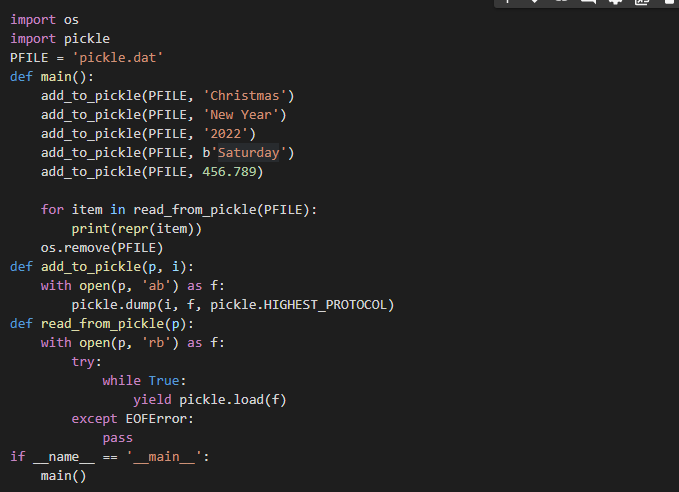Cannot Pickle Files That Are Not Opened for Reading: a
There must be many queries in your mind concerning pickle files.? This article is well-nigh how to read a pickle file in python. It will encompass the basic details of pickle files and the step-by-pace process of correctly reading them. And then, what is a pickle module or pickling?
What is a pickle module or pickling?
A pickle module or pickling is the process of serializing and deserializing python objects to a byte stream. The opposite of pickling is unpickling. Pickling is used to store python objects like classes, dictionaries, lists, etc. It is beneficial with data assay while performing routine tasks on the data, similar preprocessing. When y'all work with python specific data types like objects, classes, or dictionaries, pickling makes a lot of sense. It is specifically used to store the trained machine learning algorithms so that nosotros practise not have to constantly re-train them every time nosotros want to use them. Instead, we just store the trained machine learning algorithm one time, salvage it to a variable, and then pickle it. This mode, you tin can salvage a lot of fourth dimension even when you have a large amount of data, which takes a lot of time to load into memory.
Pickled data may take simply five seconds to load, while the new information may accept 5 – 10 minutes to load. Hence, it is better to pickle the dataset and so load it. This process would be far faster by l to 100X, in fact sometimes more than than that depending on the size of the dataset. Permit us encounter a elementary illustration of how to store a lexicon into a pickle file.
Example 1:
To store a dictionary into a pickle file, get-go import the pickle to utilize information technology. Subsequently that, define your custom dictionary. The next step is to open a file and use a pickle.dump() to put or write the dictionary into the open file and close it.
importpickle
favcolor={"red":"blue" ,"yellow":"green"}
pickle.dump ( favcolor,open ("color.p" ,"wb"))

Instance 2:
The purpose of this commodity is to explain how to read a pickle file. The lawmaking given below will help you read the information. The first step is to open the file with the dictionary data using the open() command, load all the information into a variable using the load() control, and save it in a new variable. Then you can print the variable to come across the dictionary information.
import pickle
favcolor = pickle.load ( open ( "colour.p", "rb") )

Hither is the output.

Instance three:
We will bear witness you lot how to read the pickle file using the read_from_pickle office. The read_from_pickle function is a role of pandas 0.22. Here is an instance of how to read and write a pickle file. If you keep adding information to the file, you demand to read from the file till y'all get what yous are looking for. Here is an example of how read_from_pickle is used to read pickle files.
import os for item in read_from_pickle(PFILE):
import pickle
PFILE = 'pickle.dat'
def main( ):
add_to_pickle(PFILE, 'Christmas' )
add_to_pickle(PFILE, New Yr')
add_to_pickle(PFILE, ' 2022 ')
add_to_pickle(PFILE, b'Saturday')
add_to_pickle(PFILE, 456.789)
print(repr(detail))
bone.remove(PFILE)
def add_to_pickle(p, i):
with open(p, '
pickle.dump(i, f, pickle.HIGHEST_PROTOCOL)
def read_from_pickle(p):
with open up(p, 'rb') as f:
try:
while Truthful:
yield pickle.load(f)
except EOFError:
laissez passer if proper name == ' primary:
main( )

The post-obit output will be generated after executing the above code:

What tin you lot pickle and how to unpickle files?
More often than not, whatever object can be pickled if all the attributes of that object can be pickled. However, methods, functions, and classes cannot be pickled. Moreover, information technology is not possible to pickle open file objects, database connections, and network connections. The first stride to unpickle a file is to load it back into a python plan. Utilize the open() command to open up the file with the 'rb' argument as it indicated to open the file in 'read' mode. The 'r' stands for reading way, and 'b' stands for 'binary style.'
After opening the file, assign that to a variable, then utilise pickle.load() with the variable and assign information technology to a new variable. The file information will be kept in the variable. This is how yous unpickle files in python. To ensure that the file has been unpickled successfully, only print the dictionary data by using the print() command, compare it with previous dictionary data and check its blazon with type().
Determination:
This article was about reading pickle files in python. Here we take covered what the pickle module is, the process of pickling and unpickling with the help of examples. Then we explained what tin be pickled or what cannot. In other words, what modules, objects, or classes tin can be pickled and what things cannot be pickled. The short and straightforward examples will help you learn and understand the process of reading, writing, and saving the pickle file. Read the article thoroughly and employ the examples in your programs to read a pickle file.
Source: https://linuxhint.com/read-pickle-file-python/
0 Response to "Cannot Pickle Files That Are Not Opened for Reading: a"
Post a Comment